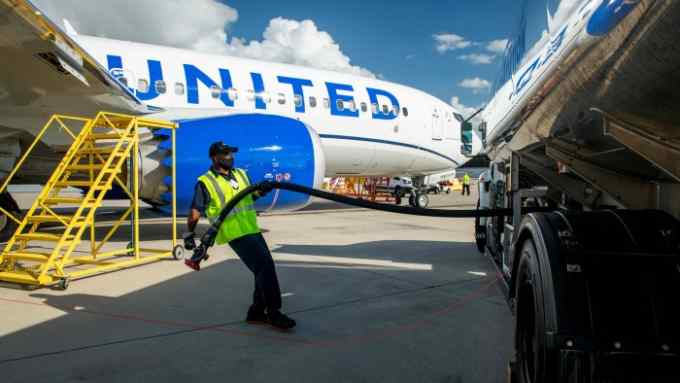Aerospace industry grounded by lost jobs and lack of staff

Simply sign up to the Coronavirus economic impact myFT Digest -- delivered directly to your inbox.
A combination of coronavirus pandemic-enforced lay-offs, staff career changes, and pent-up demand for travel is posing a huge resourcing challenge to the commercial aviation industry — at a time when its finances remain under strain.
An analysis by Oxford Economics, in conjunction with aviation trade bodies, shows that 2.3mn jobs have been lost across airlines, airports and civil aerospace groups since the outbreak of Covid-19 — a 21 per cent reduction compared with pre-pandemic levels.
But with millions of people suddenly eager to travel again as lockdown restrictions ease globally, companies are having to rush to recruit new staff.
After laying off 10,000 employees, IAG-owned British Airways is recruiting 3,000 cabin crew. Meanwhile, global airport operator Swissport wants to hire 30,000 workers, having lost 20,000 staff in an effort to slash costs when the pandemic hit.
While these shortfalls remain, however, many companies are struggling to cope. In May, the UK union Unite warned of “chronic staff shortages” across the aviation industry and said employers would pay “the price of mass sackings during the pandemic”.
Aerospace headhunter Emma Robinson explains that it is not simply a case of rehiring. “The biggest issue facing the aviation industry at the moment is a lack of staff: they’ve lost the workforce during Covid, and they have not returned.”

Robinson points out that many aviation workers were on low or minimum wage levels before the pandemic and have since found themselves “better off” in alternative jobs requiring a similar level of skills.
“They might still have a lack of job satisfaction in their new role, but they work more social hours and have a better work-life balance,” she notes. Aviation job locations can also deter candidates, post-Covid. “People don’t want to commute like they used to,” says Robinson, “meaning that, if a job can’t be done remotely, there is now a limited pool of people who live in the area that may be suitable.”
Unite has said the industry will not be able to recover from staff shortages if companies continue to “offer low wages and poor terms and conditions to new staff”. But with airlines suffering $200bn of losses due to the pandemic, paying higher wages to attract staff is not an easy solution.
Other rising costs — such as fuel — are already putting pressures on margins, which is exacerbating the problem, says Robinson. “They can’t afford to pay people more — which would attract better candidates.”
Given the unprecedented challenges faced by the aerospace industry, many workers have reported experiencing stress.
“You also have a high level of middle management burnout, due to pressures from senior leadership teams and junior team members, which can feed into a stressful workplace,” Robinson observes. To fix this, she says the sector needs “a culture change from the top down”.
She says: “Leadership is incredibly important for the culture of a business, from the way you speak to and trust staff, to their working environment — staff need to feel inspired. Processes, leadership, motivation and productivity are all vital . . . Hire well, trust your people, treat them properly, and they won’t leave.”
An effective way to bring more people into the industry is offering a range of career opportunities, according to Alison Gregory, people and change expert at management consultancy PA Consulting.
“With so many different roles across such a vast industry, there should be opportunities for people to have ‘zigzag’ careers and opportunities for secondments — helping to retain key talent and offering an attractive proposition to potential candidates,” she says.
Pierre Michard, business unit director at Welsh aircraft manufacturer STG Aerospace, believes that the sector remains attractive to anyone interested in technology and science.
“The key skill we are looking for beyond technical competence is curiosity,” he says. “We need all our designers to be inquisitive about technology and applications.”
However, Michard notes expectations and requirements vary among different demographics. “Younger designers are looking for an environment in which they can grow their knowledge base and eventually their career. One of the most common questions asked in interviews currently is: ‘who will be mentoring me?’ . . . More experienced candidates, especially those from larger organisations, are looking for an environment where they get more design freedom, and less bureaucracy.”
But to maintain the flow of skilled candidates for aerospace technology roles, some believe the industry needs government help.
John Young, head of strategic campaigns for space at BAE Systems Digital Intelligence, says: “With the escalating demand for both technical and non-technical expertise, the skills gap continues to widen. Public-private collaboration will be key to enable the next generation of skills for the space economy.”
Alongside government support and investment, he favours the idea of a national space academy that would “recover the position of such a vibrant and innovative sector”.
“A more collaborative environment,” he says, “will create common scenarios to help us tackle the talent gap, create key standards — in particular, linked to salary, as well as share industry knowledge for best practice in recruitment and retention.”

Comments